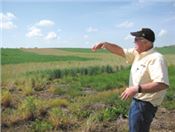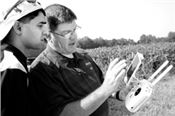|
MU Extension Seeks Farmers For Strip Trial Program
 About three-fourths of the water in Perry County’s karst lands passes About three-fourths of the water in Perry County’s karst lands passes
through channels in the rock of the county’s vast underground cave systems.
Farmers, working through programs such as MU Extension’s Strip Trial Program,
learn how to improve profits and the environment through best practices
such as no-till farming, cropping systems, cover crops and nutrient management,
says Frank Wideman, University of Missouri Extension natural resource
engineer and county program director of Perry County.
COLUMBIA, MO.
Farmers are being sought to participate in the 2017-2018 University of Missouri Extension Strip Trial Program, which helps farmers and crop advisers compare on-farm management decisions and practices.
The program uses on-farm, field-scale research to give growers farm-specific data to guide decisions that can protect or improve the bottom line, said MU Extension nutrient management specialist John Lory.
MU Extension conducts the Strip Trial Program in collaboration with the Missouri Soybean Merchandising Council, the Missouri Corn Merchandising Council and their checkoffs.
Farmers work with an MU Extension specialist or crop consultant of their choice and use their own equipment. Trials are long strips of land laid out side by side in a field with different management practices or treatments. Participants receive a personalized report on the results on their farm. They also have access to the results of other trials.
A farmer panel sets trial priorities each year. This year, the farmer panel prioritized cover crop management trials and nitrogen management trials.
One cover crop trial allows farmers to test if winter wheat can be planted successfully instead of cereal rye without lowering yields of corn or soybean.
In a new trial for 2018, farmers can test a cover crop of their choice to plant after soybean and before corn. This will help farmers and MU Extension collect real-world data on cover crop systems that might provide sufficient cover without compromising corn management after soybean. Farmers choose the type of cover crop and whether to drill or broadcast.
A third cover crop trial lets farmers test alternative termination dates for an existing cover crop. This is a great option for farmers who already have a cover crop planted and have questions about the risks and rewards with different timings for killing the cover crop, Lory said.
Researchers in the Strip Trial Program are willing to work with any farmer interested in testing delayed nitrogen applications, such as side-dressing nitrogen, or any nitrogen decision-support tool in corn, milo or wheat fields. MU specialists will be matched to individual farmers in northeastern and central Missouri.
A fifth trial examines crop response to phosphorous fertilizer. Farmers will have strips with and without phosphorous fertilizer to see where in the field yield benefits are seen.
Finally, 2018 will be the second year to test the effectiveness of ILeVO seed treatment on yield and nematode numbers.
If you are interested in having a trial on your farm, contact your local MU Extension center or one of the contacts below.
“Our goal is to have a local extension person work with you to lay out the trial,” said Lory. “In all trials, we need to get the yield map for the field after harvest. All fields are surveyed with aerial photography at least once during the growing season. And for specialized trials, such as the phosphorus trial, there may be soil sampling done by the program.”
Farmers prioritize which trials are important and volunteer to have tests on their fields.
“This program is a great collaboration between MU Extension, the corn and soybean organizations, and farmers,” Lory said. “MU brings expertise to help farmers implement the trial and bring scientific rigor to the tests and the reported results for each trial. Ultimately, Missourians all benefit from this collaboration as we integrate lessons learned about cover crops and nutrients across multiple trials and multiple years."
Lory said farmers participated in 55 trials in both 2016 and 2017. In 2018, the goal is at least 60 strip trials across Missouri.
For more information, contact Lory at loryj@missouri.edu, Greg Luce at luceg@missouri.edu or Darrick Steen at dsteen@mosoy.org. ∆

MU Extension specialists Dhruba Dhakal and Kent Shannon are using a drone to
fly over a strip trial program and taking photos. Drone technology helps them evaluate
the progress of crops and make decisions on pest and disease management.
Photo courtesy Linda Geist, University of Missouri
|
|